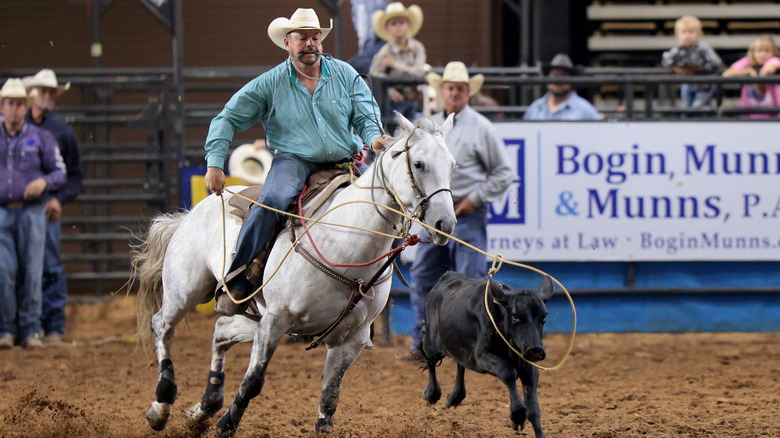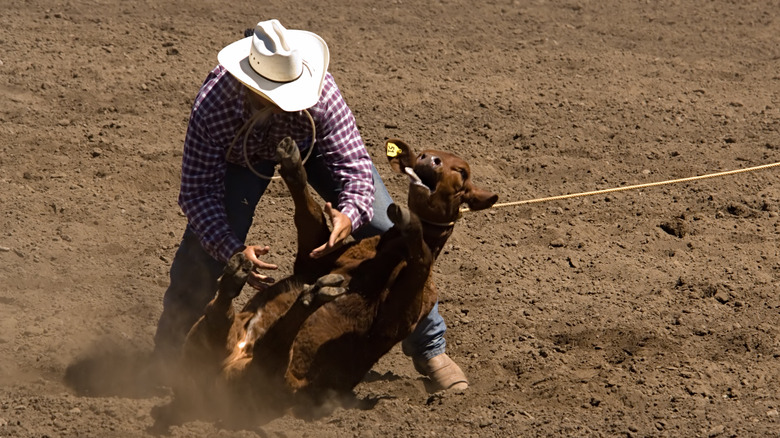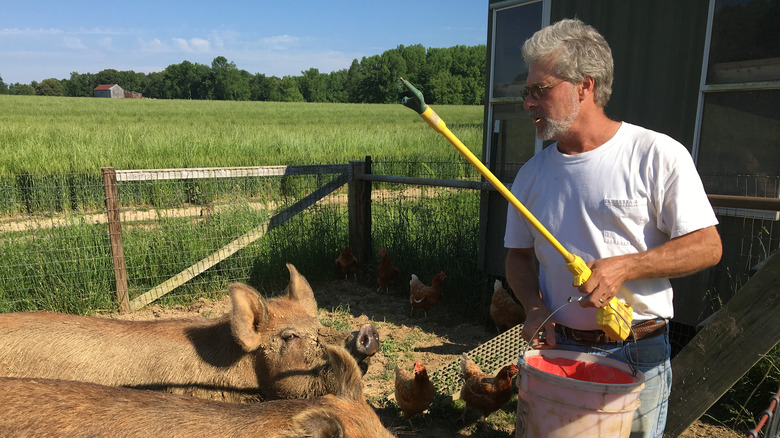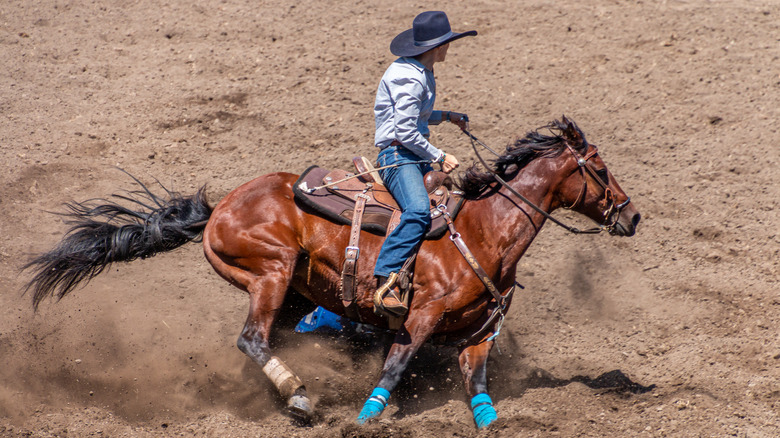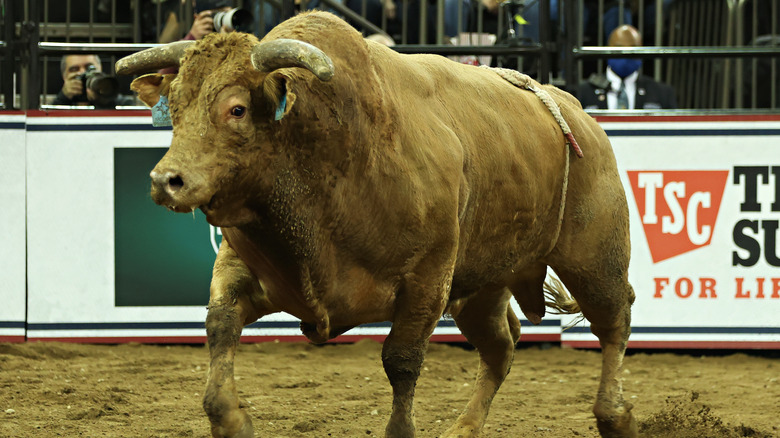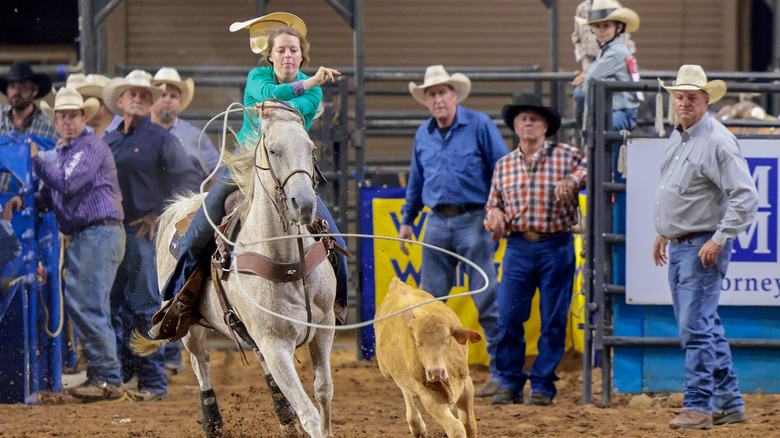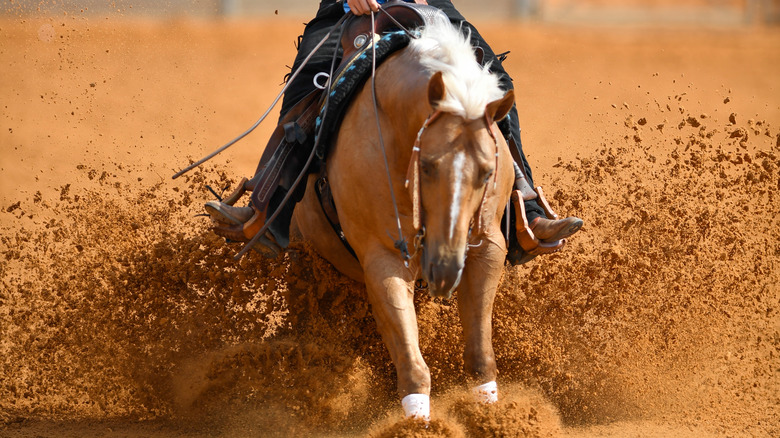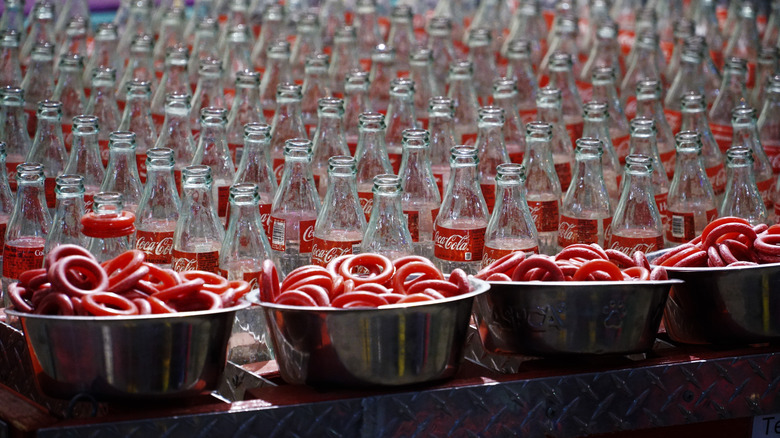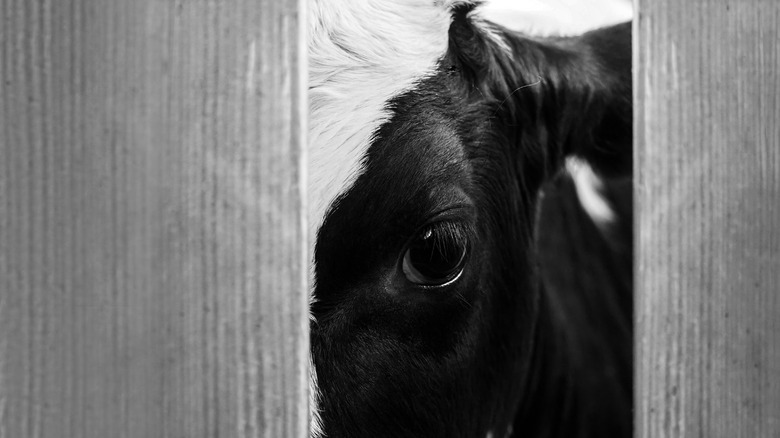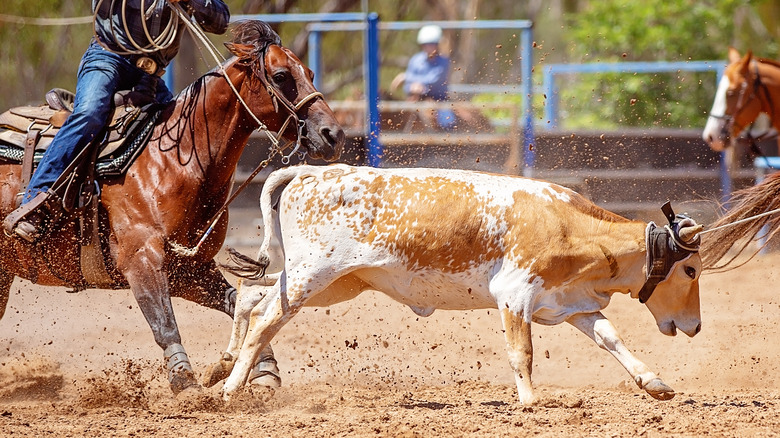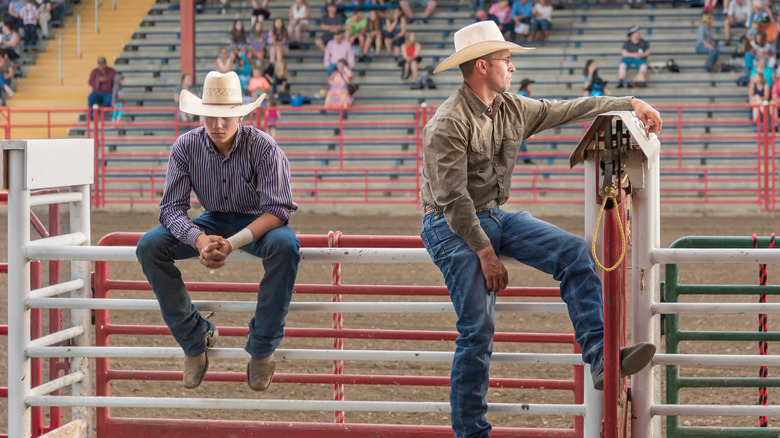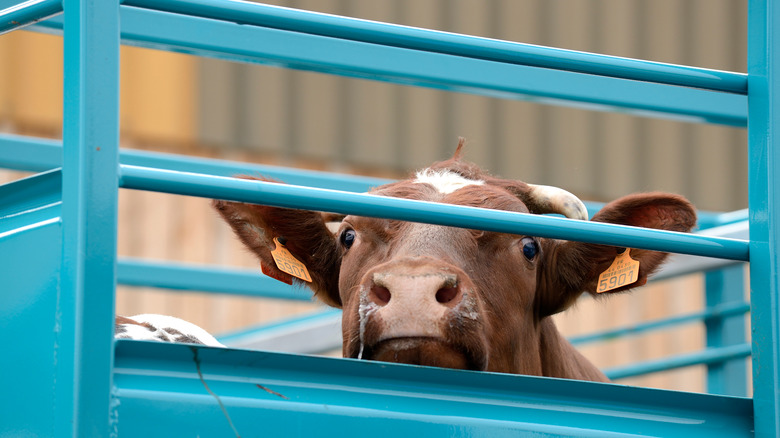Dark Secrets Of Rodeos
Some describe it as a form of culture and tradition; some describe it as senseless cruelty against animals — and, as BBC reports, the latter category seems to be gaining numbers. Humans live in the Anthropocene, an epoch where they are impacting planet Earth and their fellow creatures in an unprecedented way (via National Geographic). Luckily, humans are also becoming increasingly aware of this, which means they can show more empathy toward other animals and, before anything else, respect their right to live.
As PETA skilfully summarizes decades of anti-anthropocentric philosophy, animals are not here for human entertainment or exploitation. Unfortunately, rodeos started out as exactly that: animal exploitation for the entertainment of humans. Riders break the steers' bones, tails, and necks during events and use electric prongs and other horrifying equipment to generate aggressive, dramatic reactions in the animals, just for the public's excitement. When the animal becomes irreparably injured, it's simply shipped off to a slaughterhouse (via Adopt Animal Kits).
Sadly, very little has changed in riders' treatment of animals in rodeos over the last century. Here are the dark secrets of rodeos.
The animals always get injured in the process
Perhaps the most obvious issue with rodeos is that the animals get severely injured both during and outside the events. Animal Legal Defense Fund enumerates "broken ribs, backs, and legs, torn tails, punctured lungs, internal organ damage, ripped tendons, torn ligaments, snapped necks, and agonizing deaths" as usual consequences of rodeo events. Peggy W. Larson, a veterinarian, researcher, and former rider, spoke out against rodeos on SHARK and emphasized the numerous ways in which animals can suffer at the hands of riders.
In the process of steer tripping, the rider throws a rope around the bull's horns and then quickly pulls it while the bull is running at top speed. This tips its head at least 180 degrees so that the animal falls, and the rider then drags it on the ground and ropes its legs to score. This can result in broken necks, bones, horns, and several lacerations on the skin. It's not any better in the case of bronc riding, where horses often die while crashing blindly into the fencing. Dr. C. G. Haber, a veterinarian with extensive experience, offers arguably the most awful description (via SHARK): "I have seen cattle so extensively bruised that the only areas in which the skin was attached was the head, neck, legs, and belly. I have seen animals with six to eight ribs broken from the spine and at times puncturing the lungs."
The Hot-Shot
You might be excused for thinking cowboys get those dramatic reactions from their bulls due to years of training. In fact, it's a small electric prod that generates 4,500 volts called a Hot-Shot (via SHARK). The pain caused by the high voltage shocks the bulls and horses into jumping. None of the animals used in rodeos are aggressive by nature — not even the bulls. (The "Looney Tunes" Toro the Bull episodes were inspired by Spanish bullfighting, where the same horrors happen). As per Adopt Animal Kits,"[the animals] are physically provoked into displaying 'wild' behavior to make the cowboys look brave."
In an even sadder twist, cowboys go against the Hot-Shot regulations when they use the electric prod on rodeo animals. Miller Manufacturing Company wrote the following recommendations for the Hot-Shot (via SHARK): "We do not recommend our products be used in rodeos. We only recommend our products be used on hogs and cattle. Do not use on horses, they are much more sensitive." Hot-Shot manufacturers also advise using the prod only around the animals' rear, and SHARK clearly shows a picture of cowboys using the Hot-Shot near a horse's head.
Some people have tried the Hot-Shot on themselves and confirmed its painful effect. However, when SHARK president Steve Hindi offered rodeo riders $300 to take a short Hot-Shot jolt, no one took up the offer.
Rodeos are sold as traditional (but not all traditions are good)
As animal researcher Prof. Paula Casal writes in "Whaling, Bullfighting and the Conditional Value of Tradition," one of the most frequent justifications given by bullfighting supporters for the suffering of animals is simply that the sport is a tradition, so it's fair to continue many of the darker sides of the sport. Defending a tradition can be thus seen as protecting a country's culture. But culture evolves, and so do traditions. Crucifixion was once a tradition (and, according to "Ways of Thinking on Eastern Peoples," it might have still been practiced in Japan in the 16th century). Several traditions that were cruel to humans have been banned over the last centuries, and many argue it's time to turn toward animal suffering as well.
Unfortunately, tradition is indeed being used as a selling point in rodeos today. Per The Denver Post, "tradition" and "essential lingo" are still used to make rodeos look attractive. According to bronc rider Chet Johnson says, "The amount of care those animals get, they get spoiled." Fortunately, cruel traditions are slowly dying out: Spanish bullfighting was officially banned in Catalonia in 2011 (although, as The Conversation reports, some far-right figures like matador Morante de la Puebla are putting up a fight). Rodeos were inspired by Spanish bullfighting, as per AG Daily — perhaps the gradual ban in Spain could work as a lesson for the U.S.
Doping
As if electric rods and inflicting pain aren't enough, rodeo bulls are often injected with anabolic steroids before events so that they become even more aggressive. PETA reported a rodeo participant confessing, "Oh, I think damn near everybody's doing it." Rider Jerry Nelson described witnessing bulls he thought were injected with steroids (via The Denver Post): "Bulls with their eyes bugged out, and things like that," said Nelson. "This is no different than baseball — you can ignore it or do something. The fact is it's happening and we don't know who's doing it." Nelson also injected three bulls himself in 1997, and two of them became sterile as a consequence.
There's another gloomy twist to the story: rodeo associations try to prevent doping, but not because it harms the animal. As PETA reports, during a 2013 Calgary Stampede, a rider was suspended after administering two types of drugs to two of his steers. The association's problem wasn't that the drugs went against the animals' welfare — it was that the animals were going to be killed for food after the show. Indeed, the stampede competition is considered "terminal," with animals either dying or being terminally injured afterward.
There is nothing brave in fighting a defenseless animal
As AG Daily cowboy specialist Katie Murray reports, the origins of the American rodeo lie in the Spanish and Mexican ranchers ("rodear" means "roundup" in Spanish). The 1820s saw ranch vs. ranch contests, where cowboys would test their riding and roping skills against each other. Soon, rodeos became a display of cowboy bravery: taming a wild, aggressive animal makes you look tough, right? Sure — but if the animal is stung, prodded, tied with very tight ropes that barely allow it to breathe, and held in the arena against its will, is this such a display of bravery?
According to PETA, rodeos have become "manipulative displays of human domination over animals" driven by money and greed. With electric prods making the animals buck or run (and the steers often stressed and tired from previous injuries), it's clear it doesn't take too much courage to face the "wild" animals. And just like in the case of hunting, there is very little courage in attacking a defenseless animal — the bulls and horses hold no weapons, and they're never in control of the situation. By the time they enter the arena, they're already worn down by bucking straps (which, as PETA describes, are tightly wound around their abdomens, hurting and irritating them) and stressed by the overall situation. Of course, there still are cowboy fans out there, some even describing them as "superman cowboys," completely overlooking the animal's point of view.
Charreadas are, arguably, even worse
It can always get worse — or so it seems when taking a brief look at the charreadas, or Mexican rodeos. As per PETA, Charreadas involve several cruel variations of riding and roping steers. El "paso de la muerte," or "the pass of death," involves a rider leaping from their horse onto the bare back of a wild mare and then riding it until it becomes too tired to buck (meanwhile, three other riders chase it around, further exhausting it). In the "terna en el ruedo," one rider ties the bull by the neck, and two others tie it by the hind legs. Then, the two riders pull in opposite directions so that the bull falls and is stretched on the ground. The potential injuries are countless and among the most painful.
Then there's "coleadero" (steer tailing), where the riders grab a bull by the tail, wrap its tail around their boot and stirrup, then try to put it to the ground. The injury bulls can sustain in this process is truly horrific: it's called "degloving," and it involves the flesh on the tail being completely torn off the bone. It's baffling how these events still escape authorities and take place in the Southwest (as PETA sadly reports).
It's all a money game (so big corporations are still funding rodeos)
Of course, rodeos don't just survive because of cowboys' love for tradition: there's big money involved. Unfortunately, there are a lot of big corporations sponsoring these events and allowing the cruel sport to continue. According to SHARK, Wrangler, Coca-Cola, Dodge, and Jack Daniels (and several others, as shown here) are still funding rodeos even though they're well aware of the issues. Furthermore, Coca-Cola is also lying about not supporting rodeos (proving just how aware they are of rodeos' inherent problems).
In this video, SHARK shares a 2017 email where Coca-Cola declares they "do not sponsor any tournaments or events related to animal cruelty," along with very graphic footage of the cruel treatment of animals at events sponsored by Coca-Cola. On Coca-Cola's official website, "Animal Health and Welfare Guiding Principles" claims: "We recognize that animals are sentient beings, capable of feeling positive emotions such as joy or contentment, as well as negative emotions such as stress and fear." They also claim to have a "zero-tolerance policy for willful acts of animal abuse." However, as of 2022, they are still sponsoring several rodeos (per Event Marketer).
Rodeos are just a painful bypath to the slaughterhouse
Cowboys know all too well that the animals they drag (or prod) into the arena might get killed or injured irreparably. But as SHARK reports, this doesn't seem to be a moral problem for them, as they simply ship the injured animals to the slaughterhouse. This means that the animal is often seen as doomed from the get-go, and the riders never attempt not to hurt them during the events. Dr. Robert Fetzner, Director of Slaughter Operations for FSIS (USDA), spoke to SHARK in 1998: "Lots of rodeo animals went to slaughter. I found broken ribs, punctured lungs, hematomas, broken legs, severed tracheas and the ligamenta nuchae [necks] were torn loose."
Sadly, this is no different today. As rodeos continue to be a game of speed and a staple of traditional events, the same injuries happen over and over again, and the solution stays the same. According to SHARK, horses and bulls continue to be sent to slaughterhouses, and the rodeo organizations continue to profit even as their animals die. Adopt Animal Kits paraphrases Dr. Haber's comment that rodeos are just a detour to the slaughterhouse.
Calf roping is one of the worst traditions
Many argue that there is nothing (not even tradition) that can justify the rodeo event called "calf roping." As RSPCA reports, it involves chasing a baby cow around the arena and then lassoing it so that the calf falls to the ground. Then, the rider dismounts and pins the calf down as they tie its legs together. The possible injuries include "damage to the windpipe from the lasso, bruising and broken ribs from being violently yanked off their feet and then being forced to the ground, and choking from the tightened rope around their neck and being dragged along the ground."
All of these injuries are exemplified in horrific pictures from actual rodeos (via SHARK). In a dark twist, there are rodeo people who blatantly admit that this event hurts the calves. Action for Animals Oakland shares this quote from Keith Martin, Chairman of the Board for the Professional Rodeo Cowboys Association: "Do I think it hurts the calf? Sure I do. I'm not stupid." Of course, just a short look at some dreadful scenes involving calf roping makes it very clear that the riders see the pain the calves experience. The worst part of it, arguably, is that they don't seem to care.
PRCA lies about protecting animals
The Professional Rodeo Cowboys Association (or PRCA) has a long-standing history of lying about its animal welfare policies. As per BBC, Cindy Schonholtz, the PRCA director of industry outreach, said: "We have 60 rules that cover the care and handling of the animals." These rules involve having a veterinarian on-site during events, removing injured animals from competitions, and wrapping the bulls' horns on steers to protect their heads. The PRCA official website also has an animal welfare page where they state, "Animal welfare is a major and ongoing initiative of the PRCA."
Sadly, this only goes to show the association's hypocrisy when it comes to animal rights. Every single year, animals are badly hurt at all the rodeos the PRCA supports, with agonizing deaths still happening every year, too (via PETA). PETA associate director of campaigns and outreach Lindsay Rajt said (via BBC), "All the rules that are in the rodeo really exist to protect the rider and not the animal. Their rules are like a manual on how to abuse animals." Indeed, as long as rodeos still involve buck straps, Hot-Shots, pulling animals' necks, and slamming them on the ground, animal welfare can never be stated as PRCA's major initiative. Tellingly, after Pittsburgh banned prods and bucking straps, rodeos stopped coming to town.
Transport is a pain for the injured animals
Rodeo animals don't just experience pain during the events — they can be hurt during training, and perhaps the worst part is the transport. As PETA reports, animals are rarely given any time to rest after the stressful and painful shows and are shipped to more shows until they are too injured to participate. Then, they are shipped to the slaughterhouse. There is a myriad of issues with this.
As per SHARK, horses, bulls, and cows are transported in double-deck trailers, and the animals often end up fighting in these cramped conditions. Furthermore, when the animals are too injured to compete and sent to the slaughterhouse, they are crammed into the vehicles with life-threatening injuries, in excruciating pain, without any medical care beforehand. They are forced to stand in these conditions on the way to the slaughterhouse, basically seen as a form of food that just hasn't died yet. SHARK reports a case where a female horse was sent to the slaughterhouse, "leg dangling, across two states in a transport truck with other horses," instead of being euthanized beforehand. She died on the road.
